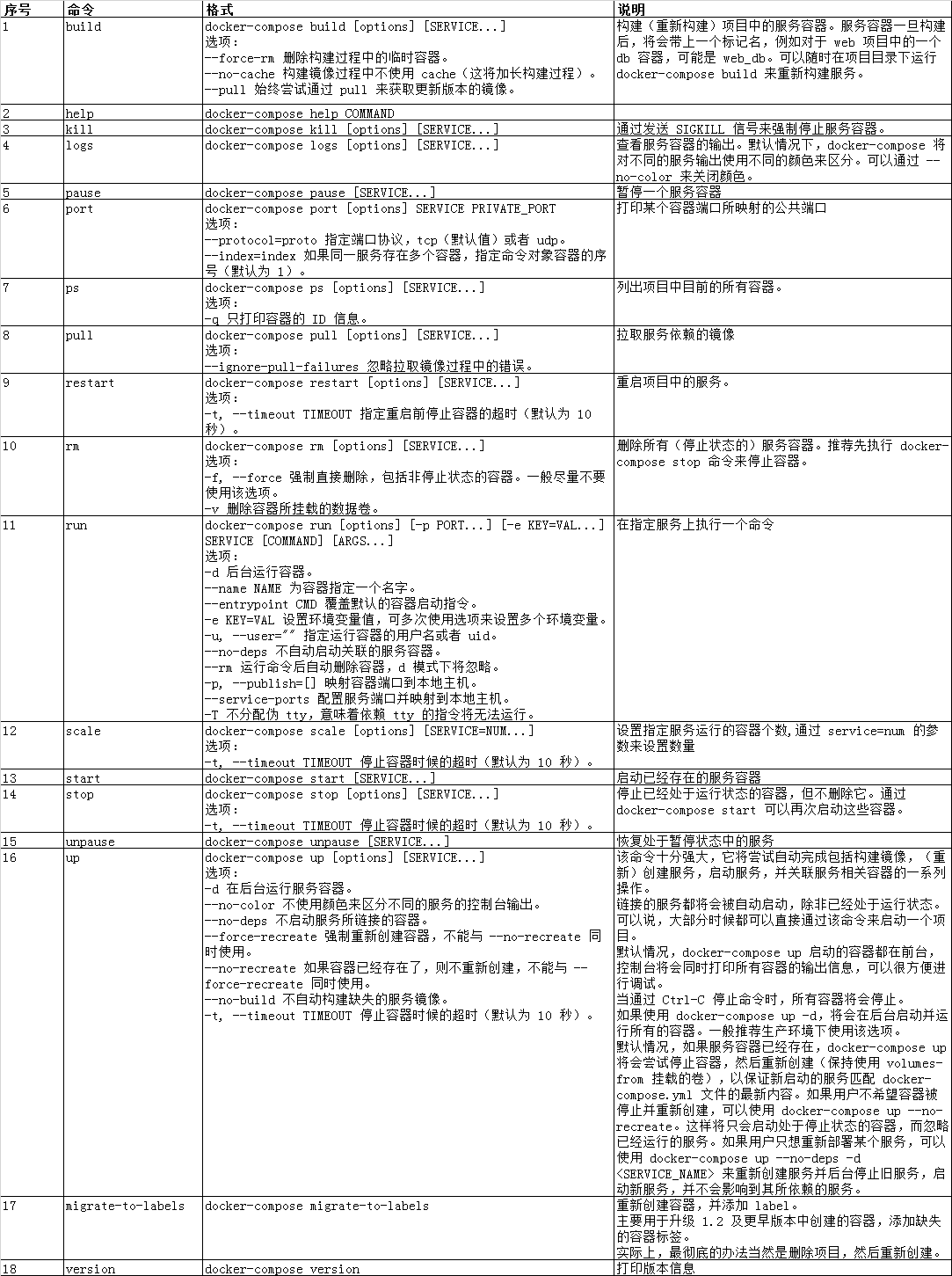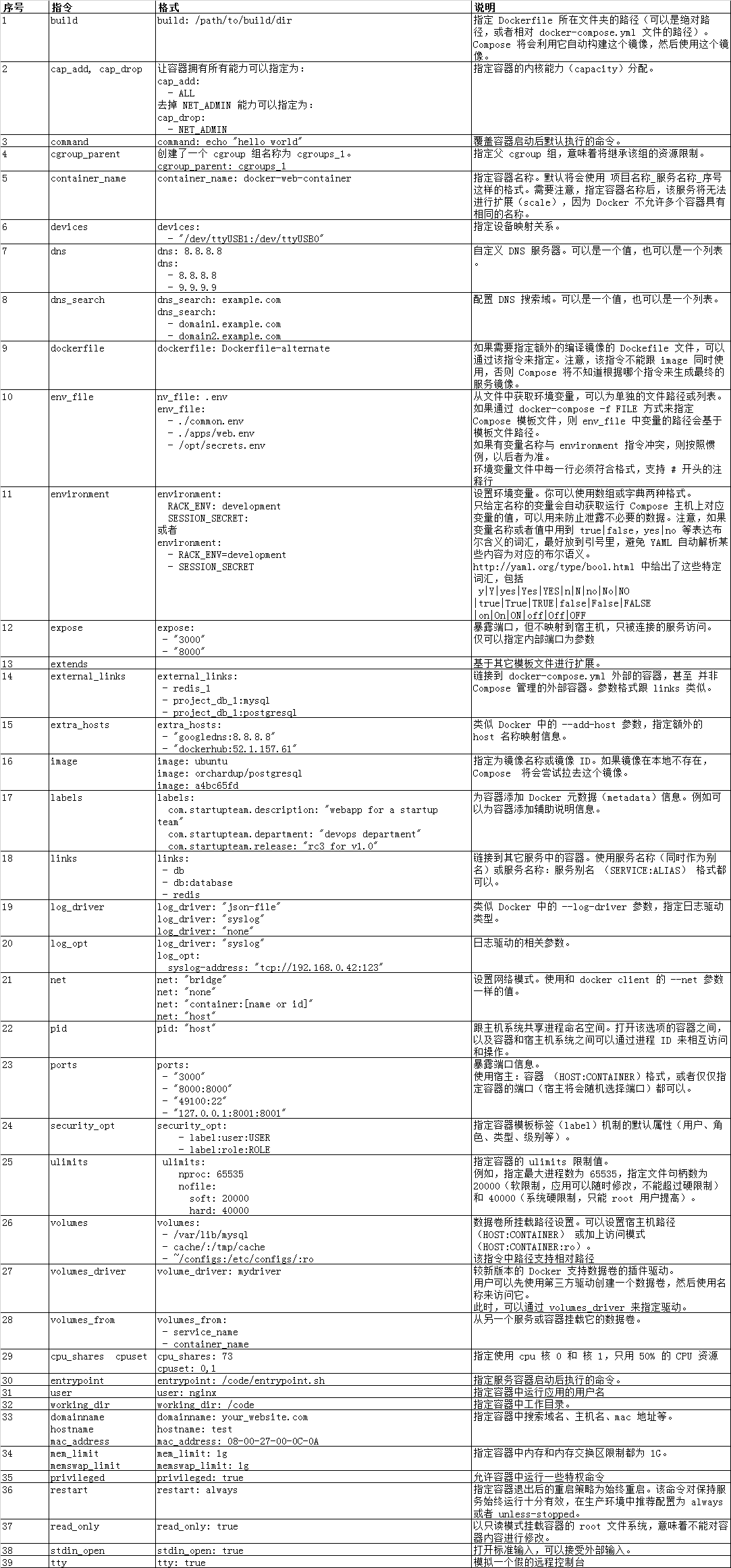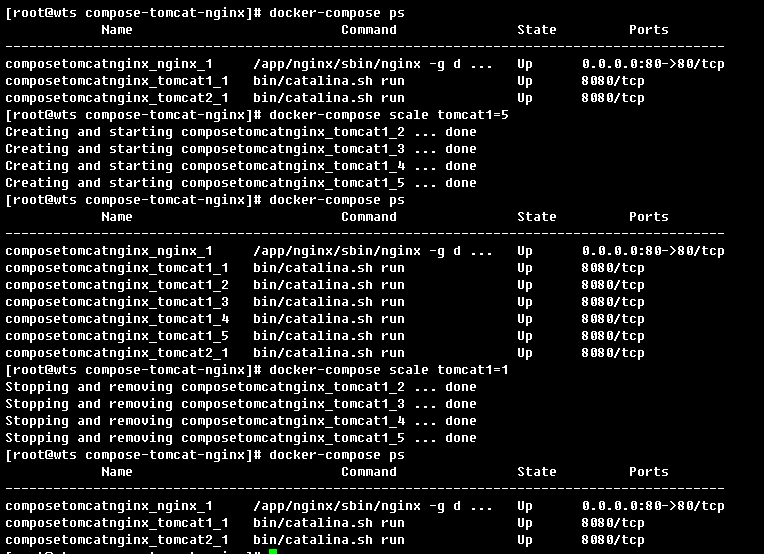Compose是Docker官方的开源项目,可以实现对Docker容器集群的快速编排。
Compose 中有两个重要的概念:
服务(service):一个应用的容器,实际上可以包括若干运行相同镜像的容器实例。
项目(project):由一组关联的应用容器组成的一个完整业务单元,在 docker-compose.yml 文件中定义。
一、安装Compose
Compose由python开发,因此可以使用pip方式进行安装。
# pip install -U docker-compose
安装成功后可以查看docker-compose的用法:
# docker-compose -h
Define and run multi-container applications with Docker.
Usage:
docker-compose [-f=<arg>...] [options] [COMMAND] [ARGS...]
docker-compose -h|--help
Options:
-f, --file FILE Specify an alternate compose file (default: docker-compose.yml)
-p, --project-name NAME Specify an alternate project name (default: directory name)
--verbose Show more output
-v, --version Print version and exit
-H, --host HOST Daemon socket to connect to
--tls Use TLS; implied by --tlsverify
--tlscacert CA_PATH Trust certs signed only by this CA
--tlscert CLIENT_CERT_PATH Path to TLS certificate file
--tlskey TLS_KEY_PATH Path to TLS key file
--tlsverify Use TLS and verify the remote
--skip-hostname-check Don't check the daemon's hostname against the name specified
in the client certificate (for example if your docker host
is an IP address)
Commands:
build Build or rebuild services
config Validate and view the compose file
create Create services
down Stop and remove containers, networks, images, and volumes
events Receive real time events from containers
exec Execute a command in a running container
help Get help on a command
kill Kill containers
logs View output from containers
pause Pause services
port Print the public port for a port binding
ps List containers
pull Pulls service images
restart Restart services
rm Remove stopped containers
run Run a one-off command
scale Set number of containers for a service
start Start services
stop Stop services
unpause Unpause services
up Create and start containers
version Show the Docker-Compose version information
添加bash补全命令:
# curl -L https://raw.githubusercontent.com/docker/compose/1.8.0/contrib/completion/bash/docker-compose > /etc/bash_completion.d/docker-compose
其它安装方式:二进制包、容器中运行。
二、Compose命令说明
格式:
docker-compose [-f=<arg>...] [options] [COMMAND] [ARGS...]
选项:
-f, --file FILE 指定使用的 Compose 模板文件,默认为 docker-compose.yml,可以多次指定。
-p, --project-name NAME 指定项目名称,默认将使用所在目录名称作为项目名。
--x-networking 使用 Docker 的可拔插网络后端特性(需要 Docker 1.9 及以后版本)。
--x-network-driver DRIVER 指定网络后端的驱动,默认为 bridge(需要 Docker 1.9 及以后版本)。
--verbose 输出更多调试信息。
-v, --version 打印版本并退出
常用命令使用说明:

三、Compose模板文件
默认的模板文件名称为 docker-compose.yml,格式为 YAML 格式。
版本1中,其中每个顶级元素为服务名称,次级元素为服务容器的配置信息,例如
webapp:
image: examples/web
ports:
- "80:80"
volumes:
- "/data"
版本2扩展了 Compose 的语法,同时尽量保持跟版本1的兼容,除了可以声明网络和存储信息外,最大的不同一是添加了版本信息,另一个是需要将所有的服务放到 services 根下面。版本2写法如下:
version: "2"
services:
webapp:
image: examples/web
ports:
- "80:80"
volumes:
- "/data"
每个服务都必须通过 image 指令指定镜像或 build 指令(需要 Dockerfile)等来自动构建生成镜像。
常用指定如下:

四、使用docker-compose编排nginx、tomcat集群
创建一个名为compose-tomcat-nginx的目录,作为项目工作目录,并在其中创建两个子目录:nginx、tomcat。目录结构如下:
# tree
.
├── docker-compose.yml
├── nginx
│ ├── Dockerfile
│ ├── nginx-1.8.0.tar.gz
│ ├── nginx.conf
│ └── nginx-sticky.tar.gz
└── tomcat
├── apache-tomcat-7.0.56.tar.gz
├── Dockerfile
└── jdk-8u73-linux-x64.tar.gz
2 directories, 8 files
docker-compose.yml文件内容如下:
# cat docker-compose.yml
tomcat1:
build: ./tomcat
expose:
- 8080
tomcat2:
build: ./tomcat
expose:
- 8080
nginx:
build: ./nginx
links:
- tomcat1:t01
- tomcat2:t02
ports:
- "80:80"
expose:
- "80"
tomcat的Dockerfile文件内容如下:
# cat Dockerfile FROM centos:6.9 MAINTAINER eivll0m@163.com ADD jdk-8u73-linux-x64.tar.gz /app ENV JAVA_HOME /app/jdk1.8.0_73 ADD apache-tomcat-7.0.56.tar.gz /app WORKDIR /app/apache-tomcat-7.0.56 ENTRYPOINT ["bin/catalina.sh","run"] EXPOSE 8080
nginx的Dockerfile文件内容如下:
FROM centos:6.9
MAINTAINER eivll0m@163.com
ADD nginx-1.8.0.tar.gz /app
ADD nginx-sticky.tar.gz /app
RUN yum -y install gcc gcc-c++ pcre pcre-devel zlib zlib-devel openssl openssl-devel
RUN cd /app/nginx-1.8.0
&& ./configure --prefix=/app/nginx --add-module=/app/nginx-sticky
&& make
&& make install
COPY nginx.conf /app/nginx/conf
cmd ["/app/nginx/sbin/nginx", "-g", "daemon off;"]
EXPOSE 80
nginx.conf文件内容如下(未优化):
# cat nginx.conf
user root root;
worker_processes 2;
#error_log logs/error.log;
#error_log logs/error.log notice;
#error_log logs/error.log info;
#pid logs/nginx.pid;
events {
worker_connections 1024;
}
http {
include mime.types;
default_type application/octet-stream;
log_format main '$remote_addr - $remote_user [$time_local] "$request" '
'$status $body_bytes_sent "$http_referer" '
'"$http_user_agent" "$http_x_forwarded_for"';
access_log logs/access.log main;
sendfile on;
#tcp_nopush on;
#keepalive_timeout 0;
keepalive_timeout 65;
gzip on;
gzip_comp_level 6;
gzip_proxied any;
gzip_buffers 4 8k;
gzip_min_length 1024;
gzip_types text/plain text/xml text/css application/x-javascript text/javascript image/jpeg;
proxy_buffer_size 64k;
proxy_buffers 32 32k;
proxy_ignore_client_abort on;
client_header_buffer_size 4k;
client_max_body_size 50m;
#send_timeout 5m;
upstream tomcat_client {
sticky;
server t01:8080 weight=1;
server t02:8080 weight=1;
}
server {
listen 80;
server_name localhost;
#charset koi8-r;
#access_log logs/host.access.log main;
location / {
proxy_pass http://tomcat_client;
proxy_redirect default;
proxy_set_header Host $host;
proxy_set_header X-Real-IP $remote_addr;
}
#location ~ ^/console/ {
# proxy_pass http://mh.lkpower.com;
# ssi on;
# proxy_redirect off;
#}
#location ~ ^/hospital/ {
# proxy_pass http://mh.lkpower.com;
# ssi on;
# proxy_redirect off;
#}
#error_page 404 /404.html;
# redirect server error pages to the static page /50x.html
#
error_page 500 502 503 504 /50x.html;
location = /50x.html {
root html;
}
# proxy the PHP scripts to Apache listening on 127.0.0.1:80
#
#location ~ .php$ {
# proxy_pass http://127.0.0.1;
#}
# pass the PHP scripts to FastCGI server listening on 127.0.0.1:9000
#
#location ~ .php$ {
# root html;
# fastcgi_pass 127.0.0.1:9000;
# fastcgi_index index.php;
# fastcgi_param SCRIPT_FILENAME /scripts$fastcgi_script_name;
# include fastcgi_params;
#}
# deny access to .htaccess files, if Apache's document root
# concurs with nginx's one
#
}
}
运行docker-compose:
# docker-compose up #前台 # docker-compose up -d #后台
其它相关命令:
# docker-compose ps # docker-compose build --no-cache --force-rm # docker-compose rm --all
# docker-compose scale tomcat1=5


弹性伸缩:

本集群实现了nginx代理后端tomcat,并实现了session保持。